
Salty Sam’s Fun Blog for Children
Number 309
Calendars
Hello Everyone

Well, here we are half way through January already. Doesn’t the time fly!
How are you doing with your New Year resolutions?
Have you kept to them? Do you even remember what they were?
A good way to keep records of our achievements is to write them in a diary.
A good way to remind to what you need to do is to write notes on a calendar.
Do you have a calendar on your wall?
We take it for granted now, that the year is divided up into measurable units. We have week days to go to school or work. We have named months which we relate to the seasons.
Our year is governed by how long it takes for the Earth to move around the Sun.
But the calendar we all use today is a relatively modern invention in human history.
Even cave men and women would notice the changing seasons. The summer would return after the winter and the stars in the sky could be seen in patterns that repeated each year.
They marked their cave walls to keep a record of what they saw and these were the first ever calendars. They were related to the cycles of nature and the ever-changing Moon.
The passage of the Sun was one of the easiest things to observe.
Have you noticed out of your windows how the Sun always sets in exactly the same place each mid-winter day and each mid-summer day? You might relate the point to a tree or a chimney pot.
When people began to live in settlements and farm the land, they needed to observe the changing seasons to know when to sow seeds.
Ancient people produced calendars that related to the Sun, we call this a solar calendar, and also calendars relating to the cycles of the Moon (a lunar calendar) and stars.
One of the first properly-designed calendars was produced by the Ancient Egyptians.
The temple priests spent time observing the movement of the stars. They noticed that Sirius rose above the horizon just before dawn at the time of year when the flooding of the Nile was about to take place. Priests who can foretell important events can give the impression that they have magical powers!
The Egyptians needed to keep in mind yearly cycles because they knew the Nile would flood every year. They needed to plan their agricultural activities around this regular phenomenon.
They divided the year into twelve months each with 30 days. Their months comprised of three weeks. This of course only created a year of 360 days which wasn’t long enough, so they added another five days to the end of the year. These five days were thought to be the birthdays of their greatest gods and were given over to feasting and celebration.
The priests did not seem to notice that every four years Sirius appeared one day later. This is because a year is nearer to 365 days and 6 hours, or put another way – a quarter of a day.
Their calendar began to slide backwards.
Later, the people from Mesopotamia developed a calendar with 12 lunar months.
Each month would begin when a crescent Moon appeared. These Babylonians were masterful astronomers and used their knowledge of the position and movement of stars to become great navigators and so were able to travel far distances in ships.
The Greeks and Romans created their own calendars which were similar but not quite the same. The first Roman calendar was drawn up by Romulus (the king who founded Rome) who had ten months in his year each lasting 30 or 31 days.
But a more famous one was made by Julius Caesar. lt was introduced in 45 BC. lt was called the Julian Calendar. Although it had 12 months they were not of the same length as the modern calendar, many were shorter.
Before this new calendar, the year started in March. The weeks had eight days.
Julius Caesar brought in the seven day week and added days to February, which was at the end of the year, to make it up to 28 days. So if you have ever thought it odd that February only has 28 days when every other month has 30 or 31, you now know why.
This calendar also incorporated a leap day, which meant that 3 consecutive years had 365 days and every fourth year had 366 days. The leap day was added to the shortest month, February.
The Julian calendar was better than the Egyptian one, but still it wasn’t exact according to modern astronomical knowledge.
The names of his months were Martius, Aprilis, Maia, Junius, Quintilis, Sextilis, September, October, November, December, Januarius and Februarius so you can see how the names are pretty similar to the month names we have today.
You can see that the year began in March. The extra day added to a leap year was put at the end of February which was the end of the year.
Quintilis relates to the Roman word for five and the months that follow relate to the numbers that follow.
We still use parts of these words in modern English.
Sextuplets are six babies born together, a septagram is a seven pointed star and an octopus has eight tentacles.
On the advice of Sosigenes, an astronomer from Alexandria in Egypt who realised a year was 365¼ days, Caesar added ninety days to the year in 46 BC and started a new calendar on 1 January in the year 45 BC.
We now know that the 6 hours is actually 5 hours, 48 minutes and 46 seconds.
The difference adds up to one day in about 130 years.
At about the same time, the Maya, who lived in what is now southern Mexico and Central America, were creating their own calendar. They established that there were 365 days in the year. They divided their year into 18 months of 20 days and added five days to the end of the year.
China, lndia, Africa and other American tribes were all creating their own versions of the calendar. The Jewish calendar is different again and is derived from the Ancient Babylonian calendar.
Many years later in 1582, Pope Gregory Xlll decreed, on advice from an astrologer, that there should be a change in the Julian calendar. Over the years, the Julian calendar had created a discrepancy of 10 days.
Gregory announced that the day after October 4 in 1582 would be October 15 – thus saving the lost ten days. The protestant countries were resentful of papal interference and reluctant to adhere to any papal command and so took time to implement the new calendar.
Britain finally adopted the new calendar in 1752 – and also changed the start of the New Year from 25th March to 1st January. By this time the difference between the two calendars was 11 days. To solve the problem, in that year, 2nd September was followed by 14th September.
There was a story that some uneducated people rioted in the streets fearing that days had been stolen from them – but modern historians now dispute this happened.
This new Gregorian Calendar was created according to precise calculations of vernal equinoxes. The vernal equinox is the one day in spring when the duration of night and day is the same.
The Gregorian calendar is inaccurate by one day in 3,236 years but scientists calculate that the Earth’s travelling speed may differ in centuries to come anyway, so we won’t worry about it, shall we?
Today, this Gregorian calendar is the most widely used calendar in the world.
Bye bye everyone – don’t forget to subscribe to my blog!
lf you like my blog, please support it by telling all your friends and followers about it.
Thank you!
And see you again next Fun Friday!
Love and kisses
Salty Sam

www.christina-sinclair.com


Bill and Bob’s Joke of the Week![]()
![]()
Bill: Did you hear about the man who got sent to prison for stealing a calendar?
Bob: What did he get?
Bill: A year!

Salty Sam © Christina Sinclair 2015
Unauthorized use and/or duplication of material from this blog without express and written permission from this blog’s author and owner is strictly prohibited.
Links may be used to www.christina-sinclair.com

Picture Gallery
 The Nile delta
The Nile delta

 Mayan calendar
Mayan calendar


 THE SALTY SAM NEWS DESK
THE SALTY SAM NEWS DESK

At the beginning of the year, Miss Pringle put a calendar up on the classroom wall.
She had listed all the things the children had to look forward to this year.
There was the summer fete and the carol concert and Miss Pringle had arranged for the class to visit The Rocky Bay Animal World at the end of the month; so that was really something to look forward to too.
Miss Pringle’s calendar had pictures on it to make it look colourful and interesting.
All calendars look different but they all have the same days of the week on them.
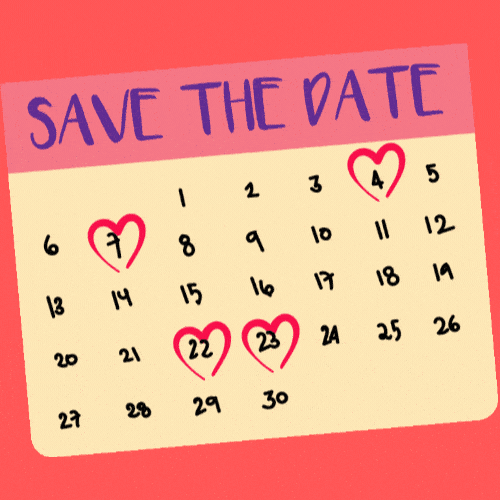
Miss Pringle’s calendar had weeks starting with Monday. Some calendars, you will notice start their weeks on a Sunday.
Each day has a special name that was decided upon a long time ago.
All the names mean something – like Monday is named after the Moon.
Miss Pringle explained that the Greeks named the days of the week after the Sun, the Moon and the five planets that were known to them.
The planets were named after the gods Ares, Hermes, Zeus, Aphrodite, and Cronus. The Greeks called the days of the week the days of their gods.
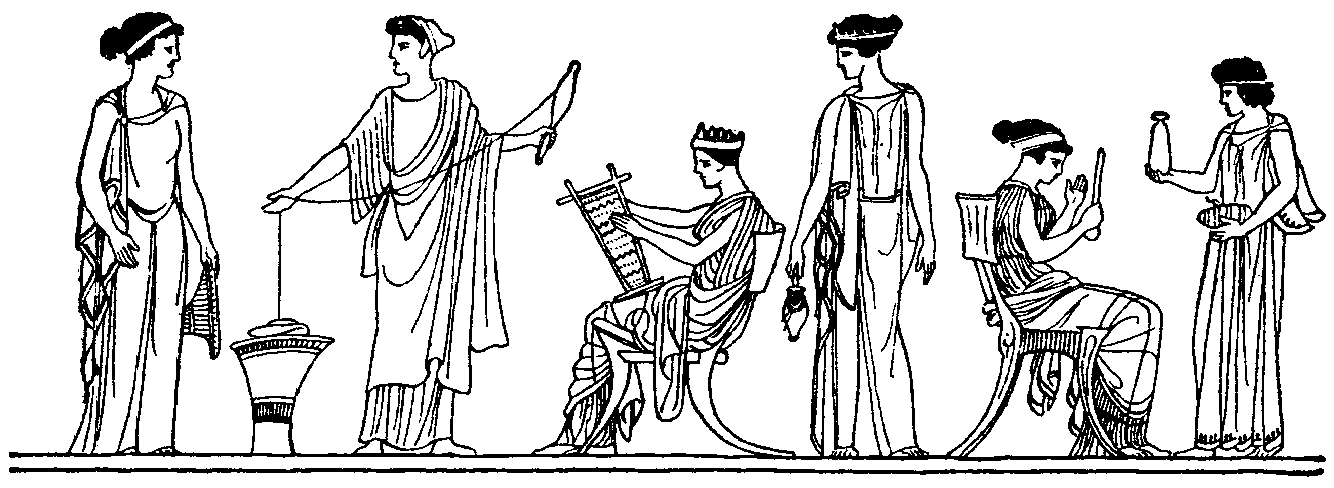
The Romans named the days after their equivalent gods – because they had different ones: Mars, Mercury, Jove (Jupiter), Venus, and Saturn.
ln Romance languages, the connection is still evident. ln French: lundi, mardi, mercredi, jeudi, vendredi but in Germanic languages, the names of the Norse gods Tiu, Woden, Thor and Freya (Tuesday, Wednesday, Thursday, Friday) replaced Mars, Mercury, Jupiter and Venus, however, they did not substitute Saturn (Saturday).

The Christian church tried to replace the word Sunday with ‘the Lord’s day’ because they thought it was too Pagan and was successful in French and Spanish with Dimanche and Domingo but not English and German with Sunday and Sonntag.
Venus is the Roman goddess of love and beauty and Freya is the Teutonic (from northern Europe) goddess of love and beauty – and a lot of people are happy when Friday comes around.
![]()
Do you get that Monday feeling?
And then it is downhill all week?
Do you get that Friday feeling?
Miss Pringle does!

This blog is very good for homeschooling – which is useful now that we are back in lockdown!
And there have been readers coming from some new places recently, this brings the list of territories where my blog is read up to 151!
So welcome to all you new readers from…
Palestinian Territory, Occupied
Trinidad and Tobago
El Salvador
Brunei Darussalam
Croatia
Libya
Ivory Coast
Uzbekistan
Bolivia


*********************
TO ADVERTISE ON THIS BLOG
PLEASE CONTACT:
christina.sinclair.ads@aol.co.uk
*********************


Hobby Time
Emily found a wonderful way to decorate paperclips this week.
She will use these markers in her planner.
lt will really help her to get organized.
She simply sewed buttons or beads onto the end of paper clips.




lt’s the Weekend!

HOW TO MAKE A WlNTER lCE ELF
This elf has come down from the higher reaches of the mountains to visit us on the blog post today.
She has a flowing gown and a tiara made from ice.
Look out for more fairy folk to make on this blog as the seasons go on.
This doll is easy for little fingers to dress but will need experienced knitter’s fingers to make.

BODY (KNIT ONE)
Using 4mm knitting needles and pink dk yarn cast on 17 stitches
Knit 24 rows of stocking stitch
Don’t cast off
Cut off the yarn leaving a length of about 20cm and thread this through the stitches on your needle and pull the knitting needle away
ARMS (KNIT TWO)
Using 4mm knitting needles and pink dk yarn cast on 6 stitches
Knit 8 rows of stocking stitch
Don’t cast off
Cut off the yarn leaving a length of about 10cm and thread this through the stitches on your needle and pull the knitting needle away
LEGS (KNIT TWO)
Using 4mm knitting needles and pink dk yarn cast on 8 stitches
Knit 14 rows of stocking stitch
Don’t cast off
Cut off the yarn leaving a length of about 10cm and thread this through the stitches on your needle and pull the knitting needle away
TO MAKE UP
- Sew up the back seam of the body and head right sides together using over-sew stitching
- Turn the body and head the right way out
- Pull the top of the head shut then stuff the head and body (you may need to put a couple of extra stitches in the top of the head in pink yarn to close up the little hole)
- Sew along the inner leg seams using over-sew stitching right sides together and turn the legs the right way out
- Tightly bind the ankles twice around with pink yarn
- Stuff the legs
- Sew across the top of the legs and the bottom of the body from behind (lay the legs across the stomach as you work) to attach the legs
- Sew a strand of pink yarn into the back of the neck and wrap it around the neck a couple of times, pull tight and secure the yarn into the centre back of the neck
- Embroider a face onto the front of the head using one strand of black yarn (you can pull double knitting yarn apart to get thinner strands)
- Sew along the under arm seams using over-sew stitching right sides together and turn the arms the right way out
- Tightly bind the wrists twice around with pink yarn
- Stuff the arms with the ends of the yarn left over from the knitting and a little stuffing as well
- Sew the arms securely to the sides of the body so that they point forward
- Wind some white yarn around the length of a pack of cards 10 times and sew the front of the loops to the top of the head so that the long hair flows down the back of the neck
- Wind some white yarn around the length of a pack of cards 30 times and sew the centre of the loops to the top of the head so that the long hair flows down each side of the head – your sewing should look like a centre parting
- Slightly trim the ends of the hair if necessary
Now you are ready to dress the doll…
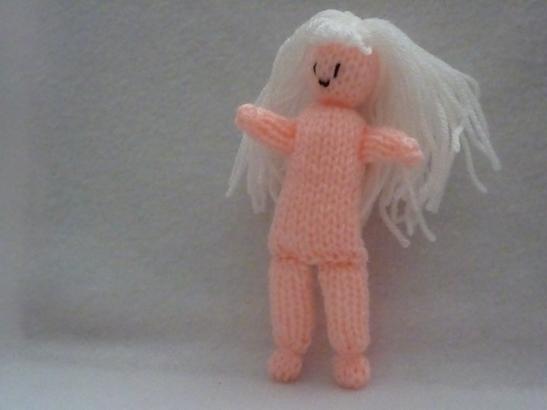
DRESS (KNIT TWO)
Using 4mm knitting needles and white sparkly yarn cast on 11 stitches
Purl 1 row
Purl 1 row
Slip 1, (knit 1, purl 1) repeat the last 2 stitches to the end of the row
Repeat the last row 37 times (38 rows of moss stitch)
Purl 1 row
Purl 1 row
Cast off
COAT BACK (KNIT ONE)
Using 4mm knitting needles and light blue yarn cast on 28 stitches
Knit 6 rows of garter stitch
Continue knitting in stocking stitch for 24 rows
Decrease 1 stitch at the beginning of every third row and every fourth row until 16 stitches remain
Knit 8 rows of stocking stitch
Purl 1 row
Purl 1 row
Cast off
COAT LEFT FRONT (KNIT ONE)
Using 4mm knitting needles and light blue yarn cast on 10 stitches
Knit 6 rows of garter stitch
Continue knitting in stocking stitch for 24 rows
Decrease 1 stitch at the beginning of every third row out of four (every other knit row) until you have 4 stitches
Knit 10 rows of stocking stitch
Cast off
COAT RIGHT FRONT (KNIT ONE)
Using 4mm knitting needles and light blue yarn cast on 10 stitches
Knit 6 rows of garter stitch
Continue knitting in stocking stitch for 24 rows
Decrease 1 stitch at the beginning of every fourth row (every other purl row) until you have 4 stitches
Knit 10 rows of stocking stitch
Cast off
COAT FRONT BORDERS (KNIT TWO)
Using 4mm knitting needles and light blue yarn cast on 5 stitches
Slip 1, (knit 1, purl 1) repeat the last 2 stitches to the end of the row
Repeat the last row 45 times (46 rows of moss stitch)
Cast off
COAT SLEEVES (KNIT TWO)
Using 4mm knitting needles and light blue yarn cast on 20 stitches
Knit 2 rows of garter stitch
Continue knitting in stocking stitch
Decrease 1 stitch at the beginning of the next 6 rows (14sts)
Cast off
COLLAR (KNIT ONE)
Using 4mm knitting needles and white sparkly yarn cast on 4 stitches
Knit 28 rows of garter stitch
Cast off
TRAIN (KNIT ONE)
Using 4mm knitting needles and white sparkly yarn cast on 17 stitches
Slip 1, (knit 1, purl 1) repeat the last 2 stitches to the end of the row
Repeat the last row 49 times (50 rows of moss stitch)
Cast off
HAIRBANDS (CROCHET ON IN WHITE AND ONE IN BLUE)
Crochet 20 chains
Add a blue sparkly pompom to the blue band
TO MAKE UP
Sew up shoulder seams and side seams of dress with right sides together using over-sew stitching (make sure the head and arms of the doll will fit through the gaps you have left)
Continue to sew up the coat in the same way
- Sew the front borders to the coat fronts
- Sew up the coat shoulder seams
- Sew the tops of the sleeves to the shoulders
- Sew up the under arm and side seams
- Sew the bottom of the sleeves together half way up the outer edge
- Sew the collar to the top of the stocking stitch knitting
- Sew the top of the train to the coat under the ridge at the top of the back
Tie the white hair band to the ends of the hair
Tie the blue hair band over the head
Push the hair up behind the coat collar
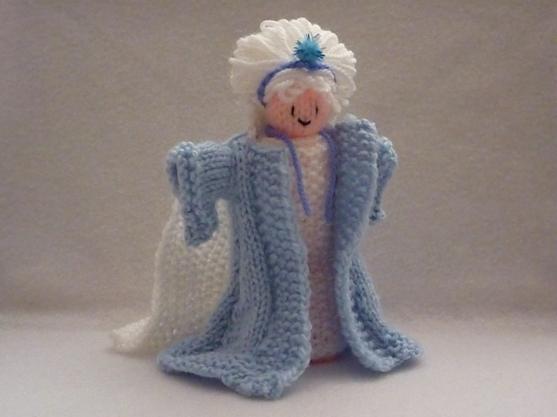
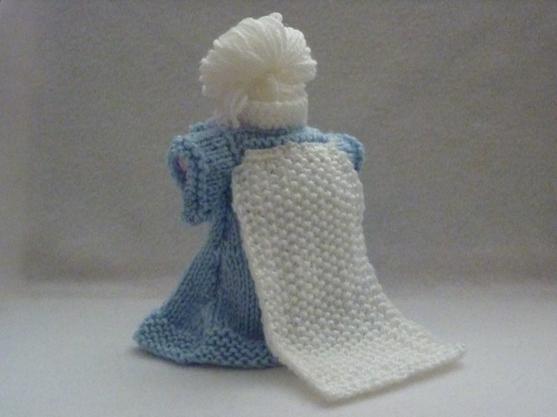
Please note that the material on this blog is for personal use and for use in classrooms only.
It is a copyright infringement and, therefore, illegal under international law to sell items made with these patterns.
Use of the toys and projects is at your own risk.
©Christina Sinclair Designs 2015



